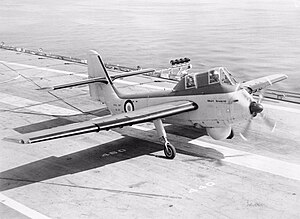Short Seamew
| SB.6 Seamew | |
|---|---|
 |
|
| A Seamew landing on HMS Bulwark (R08), 1955 | |
| Role | Anti-submarine aircraft |
| Manufacturer | Short Brothers |
| First flight | 23 August 1953 |
| Retired | 1957 |
| Primary users |
Royal Navy Fleet Air Arm Royal Naval Volunteer Reserve |
| Number built | 26 |
The Short SB.6 Seamew was a British aircraft designed in 1951 by David Keith-Lucas of Shorts as a lightweight anti-submarine platform to replace the Royal Navy Fleet Air Arm (FAA)'s Grumman Avenger AS 4 with the Reserve branch of the service. It first flew on 23 August 1953, but, due to poor performance coupled with shifting defence doctrine, it never reached service and only 24 production aircraft had flown before the project was cancelled. It has been described as a "camel amongst race-horses".
The Short Seamew was selected to fulfill Admiralty Specification M.123D for a simple, lightweight anti-submarine aircraft capable of unassisted operation from any of the Royal Navy's aircraft carriers in all but the worst of conditions, in particular escort carriers which the UK still had in considerable numbers from World War Two. Although specifically designed for naval operations, the Seamew was also intended for land-based use by the RAF. It was to be suitable for mass production and operation by the Air Branch of the Royal Naval Volunteer Reserve (RNVR). This specification was in response to the alarming increase in capabilities of the Soviet submarine forces following the Second World War.
Three prototypes were ordered in April 1952 and the first flight (XA209), piloted by test pilot Sqn. Ldr. Walter J. "Wally" Runciman, took place on 23 August 1953. This same aircraft, also piloted by Runciman, took part in the 1953 Farnborough Airshow three weeks later. In 1954 both XA209 and the second prototype XA213 took part at Farnborough, where the following year both prototypes and two production AS Mk 1 models (XE171 and XE172) gave a formation display.
The fourth Seamew prototype (XE175) was flown by Runciman for a series of sales tours in 1956 to Italy (March), Yugoslavia (April) and West Germany (May). It was this same aircraft in which Runciman was killed when it crashed during the Sydenham (Belfast) Air Display on 9 June 1956. Rumours that the crash had been caused by a material failure were current at the time but the accident investigation board did not confirm them.
...
Wikipedia
